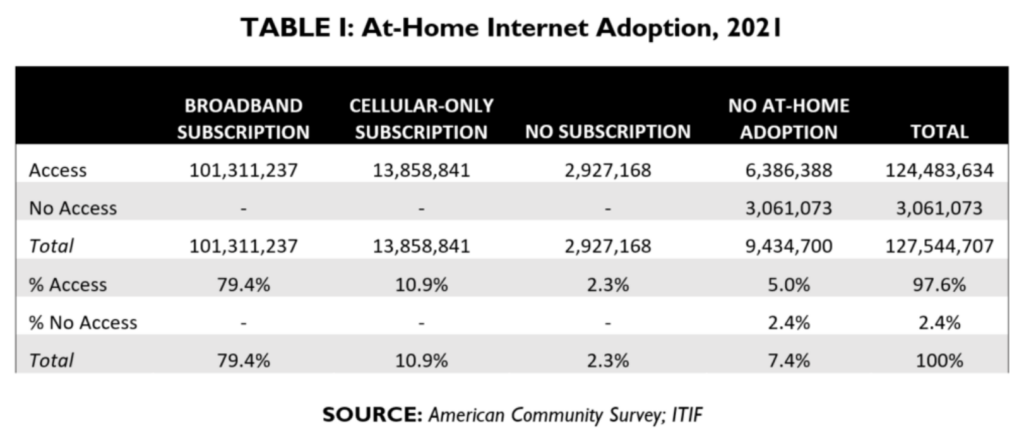
School’s back in session and the Telecom Hootenanny is heating up. We’ve got a hot-off-the-presses issue brief on the ACP, more BEAD agonistes, and the latest on spectrum auctions.
The Affordable Connectivity Program: ‘Good Enough’ to Keep Funding
In a new International Center for Law & Economics (ICLE) issue brief, Kristian Stout and I examine the $14 billion Affordable Connectivity Program (ACP) and consumer broadband subsidies more broadly. We conclude that the ACP—warts and all—is a much better policy than other alternatives, such as direct rate regulation or municipal broadband. Thus, we argue, the ACP should continue and continue to be funded, with some straightforward adjustments.
First, we found that more than 93% of U.S. households use the internet at home. Of those who don’t, two-thirds say they have access, but have not adopted at-home internet. Due to what appears to be inelastic demand among non-adopters, the ACP has faced difficulties in stimulating sufficient interest among some segments of the remaining unconnected households that could access the internet, but fail to take up service.

To be fair, however, the ACP’s subsidies appear to have successfully enabled already-subscribed households to maintain at-home internet service through the COVID-19 pandemic, thereby proving effective at allowing economically vulnerable inframarginal consumers to remain connected.
Second, we note that the ACP’s eligibility rules are quite broad. For example, if a child is enrolled in Medicaid or qualifies for free or reduced lunch at school—regardless of household income—then the child’s household would be eligible for ACP. It is estimated that approximately 40% of U.S. households are eligible for the program.
Third, while it’s relatively easy to qualify for the ACP, it’s also relatively difficult to enroll. At least two-thirds of eligible households do not participate in the ACP. Unawareness of the ACP is a significant factor driving the low uptake rate. A survey of ACP-eligible households reports that 53% of respondents had either never heard of the program or had heard of it, but didn’t know anything about it.
The ACP’s current enrollment process is cumbersome and confusing for both consumers and providers. Consumers have to apply for the program through a website or a mail-in application, verify their eligibility through various documents or databases, and contact a participating provider to select a service plan. Some providers may have an alternative application that they ask consumers to complete. Providers have to verify customers’ eligibility through a national verifier system, report data on their enrollments and reimbursements, and comply with various rules and requirements. These complexities create barriers and inefficiencies for both parties.
Based on these observations, we offer three recommended adjustments to the ACP
- Design eligibility criteria to target low-income non-adopters and vulnerable infra-marginal households.
- Provide targeted outreach to increase awareness among eligible households.
- Reduce enrollment complexities.
These reforms would make the ACP more efficient and effective. They would likely reduce the program’s costs, thereby allowing more of the appropriated funds to be directed toward the households the program is intended to help.
The BEAD Pile-On Continues
They say money can’t buy happiness and that seems to be the case with the $42.45 billion Broadband Equity Access and Deployment (BEAD) Program.
States are complaining about the program’s “fiber-above-all” preference and its Buy American requirements. Industry associations and digital-equity advocates have jointly signed a letter urging alternatives to the BEAD program’s letter-of-credit requirement.
Now, Congress is joining the airing of grievances. Last week, the U.S. Senate Commerce Committee’s Republicans, under Ranking Member Ted Cruz (R-Texas), released a report on the National Telecommunications and Information Administration’s (NTIA) allocation of funds under BEAD. In announcing the report, the committee minority echoed concerns previously raised by Senate Minority Whip John Thune (R-S.D.) and several other Republican senators:
[T]he administration has layered requirements that will drive up overall program costs, burn through funding, and could in turn leave significant numbers of unserved Americans without access. Specifically, Biden administration rules are heavily biased towards expensive fiber projects and discourage alternative more cost-effective technologies like high-speed satellite. This bias becomes even more concerning since some areas set to be funded include beachfront properties, mountain vacation homes, and remote islands, as well as Delaware’s own Biden Environmental Training Center.
The committee seems especially irked at the District of Columbia’s allocation. According to NTIA, the city has 184 locations “unserved” by broadband and will receive more than $100 million in BEAD funding, or nearly $550,000 per location. Moreover, the report points out that one-third of these locations are inside the National Zoo. To bring the point home, the report includes some photos of web-surfing zoo animals to demonstrate that the zoo is already connected. (As an aside: when you’re being hunted by foxes, the digital divide is probably not your first priority.)

BEAD is a gusher of funding that can be helpful to bring high-speed internet access to unserved populations. But it’s experiencing enormous hiccups and headaches, and there is a real risk that it will not deliver.
Is the Spectrum-Auction Hostage Crisis Coming to an End?
In March, Congress allowed the Federal Communications Commission’s (FCC) spectrum-auction authority to lapse for the first time since it was granted to the commission in 1994. Last summer, T-Mobile paid $304 million for 7,156 licenses of 2.5 GHz spectrum. But the FCC claims that it cannot issue licenses for the 2.5 GHz spectrum to T-Mobile until its auction authority is reinstated.
Some have speculated that T-Mobile licenses are being held hostage by the FCC to encourage Congress to renew the agency’s auction authority. (We’ve argued elsewhere that Congress should renew the FCC’s auction authority.)
Last week, Sen. John Kennedy (R-La.) took a small step in that direction, filing a bill to grant the FCC explicit authority to issue 2.5 GHz licenses to T-Mobile.
There’s a lot more telecom happenings to come this fall: digital discrimination, Universal Service Fund rates, low-Earth-orbit satellites, and artificial intelligence. It’s hootenanny season.




